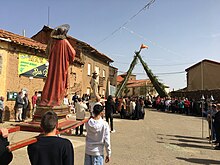| This article needs additional citations for verification. Please help improve this article by adding citations to reliable sources. Unsourced material may be challenged and removed. Find sources: "Coomonte" – news · newspapers · books · scholar · JSTOR (May 2024) (Learn how and when to remove this message) |
| Coomonte, Spain | |
|---|---|
 | |
| Country | |
| Autonomous community | |
| Province | |
| Municipality | Coomonte |
| Government | |
| • Alcalde (Mayor) | Maximiliano Federico Velicias Baladrón |
| Area | |
| • Total | 10 km (4 sq mi) |
| Elevation | 732 m (2,402 ft) |
| Population | |
| • Total | 175 |
| • Density | 18/km (45/sq mi) |
| Time zone | UTC+1 (CET) |
| • Summer (DST) | UTC+2 (CEST) |

Coomonte is a municipality and a town located in the province of Zamora, Castile and León, Spain. According to the 2023 Census (INE), the municipality has a population of 175 inhabitants.
Geography
The municipality is formed by just one population nucleus, and it is located at the north border of the Province of Zamora, bordering with León. The surrounding municipalities of Coomonte are Alija del Infantado (North), Villaferrueña (West), Maire de Castroponce (West) and Santa María de la Vega (South).
History
The first written references about Coomonte are dated about the Late Middle Ages. They refer to the Church of San Juan (Saint John Baptist), their priests and donations made to the monastery of San Esteban de Nogales. During the 14th and 15th centuries there were several documents naming the council ("concejo") of Coomonte. Most of the documents of the Middle Ages and the Renaissence that contains the name of the town are court orders ("ejecutorias").
During the early 16th century, the council of Coomonte hired the dutch painter Juan de Holanda to make the altar of the church. During that century soldiers of Coomonte took part in the wars of the King of Spains, for example in 1580, enlisting them to the war of Philip II to the annexation of Portugual to the Spanish Crown.
During the 17th century, is known thar the flood of the Órbigo river caused catastrophic events and the population decresed. Along this century, also are frequent the documentation about court orders and census.


In the 18th century the historic information is higher in part because the Catastro of Ensenada give us many data about economic life and professions in the town. Including the reference to the traditional wineries owned to domestic use by the families.
List of mayors
| Period | Name | Political party |
|---|---|---|
| 1979-1982 | José Morán Miguélez | UCD |
| 1982-1983 | Manuel Ortiz Martínez | UCD |
| 1983-1987 | Andrés Peñín Martínez | AP |
| 1987-1991 | Magín Rebordinos Panchón | PP |
| 1991-2011 | Mateo José Otero Rubio | PP |
| 2011-2023 | Magín Rebordinos Morán | PP |
| 2023- | Maximiliano Federico Velicias Baladrón | XCM |
References
- "Zamora: Población por municipios y sexo". INE Instituto Nacional de Estadística (National Institute of Stadistics of Spain). 2023.
- "Zamora: Población por municipios y sexo". INE Instituto Nacional de Estadística (National Institute of Stadistics of Spain). 2023.
- ^ Villar Hidalgo, Ursino (1989). Alija del Infantado (in Spanish). Ediciones U.V.H.
- ^ "PARES Archivos Españoles (Spanish Historic Archives)". PARES Archivos Españoles (Spanish Historic Archives), search: Coomonte.
- "MINISTERIO DE CULTURA - Portal de Archivos Españoles". pares.mcu.es. Retrieved 2024-05-24.
- Ministerio del Interior de España (ed.). "Sistema de Información Local". Archived from the original on 7 February 2017. Retrieved 4 February 2018.
42°07′N 5°49′W / 42.117°N 5.817°W / 42.117; -5.817
This article about a location in the province of Zamora, Spain is a stub. You can help Misplaced Pages by expanding it. |